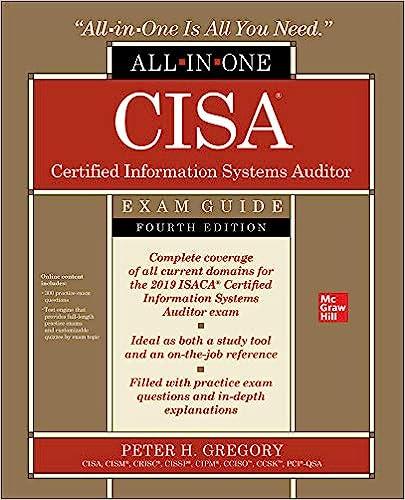Question
1. The concept of proper cutoff is most closely related to which two of these assertions? a. Existence or occurrence, and completeness. b. Existence or
1. The concept of proper cutoff is most closely related to which two of these assertions?
a. Existence or occurrence, and completeness.
b. Existence or occurrence, and accuracy (valuation).
c. Valuation or allocation, and presentation and disclosure.
d. Completeness, and classification.
e. Rights and obligations, and valuation or allocation.
2. In testing the completeness assertion, an auditor ordinarily tests in which direction?
a. From the financial statements to the potentially prematurely recorded items.
b. From the potentially prematurely recorded items to the financial statements.
c. From the supporting source documents to the accounting records.
d. From accounting records to the supporting source documents.
e. From the general ledger to the subsidiary ledger.
3. Which of the following statements is most accurate about the reliability of audit evidence?
a. Information obtained indirectly from independent outside sources is more persuasive than the auditor's direct personal knowledge obtained through observation and inspection.
b. The reliability of audit evidence refers to the amount of corroborative evidence obtained.
c. Verbal statements of fact by management are as reliable as documentary evidence.
d. To be viewed as reliable, audit evidence must be obtained from outside the audited entity.
e. The more effective the entity's internal controls, the more assurance it provides about the reliability of the accounting data and financial statements.
4 Which of the following circumstances would most likely conceal a misappropriation of cash and be least likely to be detected by an auditor?
a. Understating the sales journal.
b. Understating the cash receipts journal Understating the sales journal.
c. Overstating the accounts receivable subsidiary ledger.
d. Overstating the accounts receivable control account.
e. Understating the allowance for uncollectibles.
5. Audit evidence is generally considered "sufficient" when a. it is appropriate.
b. it has been obtained from independent sources from outside the client entity.
c. it has the qualities of being reliable and relevant.
d. there is enough of it to afford a reasonable basis for an opinion on the financial statements.
e. it has been obtained by random selection.
6. In designing the required written audit plan (also called an audit program), an auditor should establish specific audit objectives that relate primarily to the
a. cost of obtaining sufficient competent evidential matter.
b. financial statement assertions.
c. stability of data used for analytical procedures.
d. timing of tests of controls.
e. likelihood of being sued for failure to use due care.
7. Which of the following types of audit evidence is considered to be the most reliable?
a. Prenumbered client shipping documents.
b. Client work sheets documenting their manufacturing cost allocations.
c. Client personnels verbal responses to the auditors inquiries.
d. Confirmation of a customers accounts receivable balance sent directly by the customer to the auditor.
e. Speculation in a local newspaper that a client company may have financial difficulties.
8. Suppose that an auditor calculated the inventory turnover ratio for a client and saw that the current years ratio had fallen to 3, whereas the prior years ratio was 15. Which assertion would likely be called into question? a. Authorization. b. Cutoff. c. Valuation. d. Presentation. e. Classification.
9. For all audits of financial statements made in accordance with generally accepted auditing standards, the use of analytical procedures is required to some extent
In the planning stage As a substantive test In the review stage
a. Yes Yes Yes
b. No Yes Yes
c. Yes Yes No
d. Yes No No
e. Yes No Yes
10. AICPA Professional Standards identify 4 considerations that are important to the effectiveness and efficiency of analytical procedures used for substantive purposes. These include all of the following, except for
a. The nature of the assertion.
b. The availability and reliability of the data.
c. The auditors reliance on the entitys internal control.
d. The precision of the expectation.
e. The predictability of the relationship.
Step by Step Solution
There are 3 Steps involved in it
Step: 1

Get Instant Access to Expert-Tailored Solutions
See step-by-step solutions with expert insights and AI powered tools for academic success
Step: 2

Step: 3

Ace Your Homework with AI
Get the answers you need in no time with our AI-driven, step-by-step assistance
Get Started


